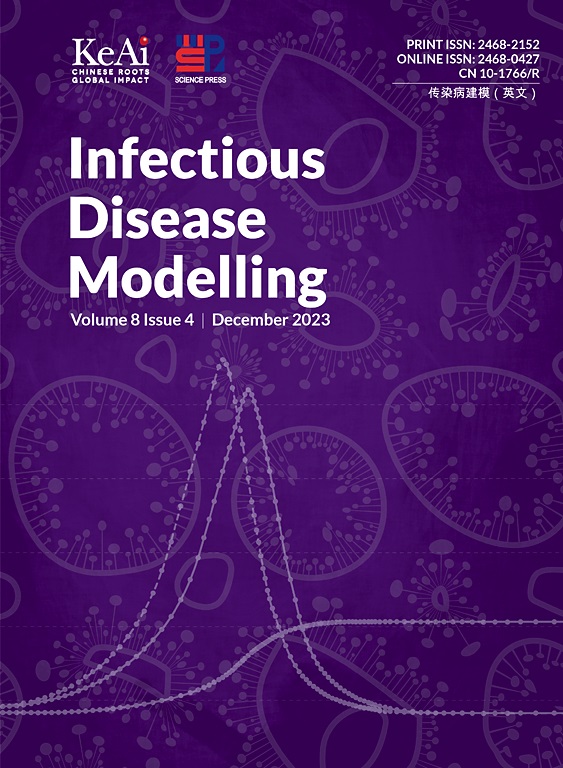Impact of vaccination on Omicron's escape variants: Insights from fine-scale modelling of waning immunity in Hong Kong
IF 8.8
3区 医学
Q1 Medicine
引用次数: 0
Abstract
COVID-19 vaccine-induced protection declines over time. This waning of immunity has been described in modelling as a lower level of protection. This study incorporated fine-scale vaccine waning into modelling to predict the next surge of the Omicron variant of the SARS-CoV-2 virus. In Hong Kong, the Omicron subvariant BA.2 caused a significant epidemic wave between February and April 2022, which triggered high vaccination rates. About half a year later, a second outbreak, dominated by a combination of BA.2, BA.4 and BA.5 subvariants, began to spread. We developed mathematical equations to formulate continuous changes in vaccine boosting and waning based on empirical serological data. These equations were incorporated into a multi-strain discrete-time Susceptible-Exposed-Infectious-Removed model. The daily number of reported cases during the first Omicron outbreak, with daily vaccination rates, the population mobility index and daily average temperature, were used to train the model. The model successfully predicted the size and timing of the second surge and the variant replacement by BA.4/5. It estimated 655,893 cumulative reported cases from June 1, 2022 to 31 October 2022, which was only 2.69% fewer than the observed cumulative number of 674,008. The model projected that increased vaccine protection (by larger vaccine coverage or no vaccine waning) would reduce the size of the second surge of BA.2 infections substantially but would allow more subsequent BA.4/5 infections. Increased vaccine coverage or greater vaccine protection can reduce the infection rate during certain periods when the immune-escape variants co-circulate; however, new immune-escape variants spread more by out-competing the previous strain.
疫苗接种对 Omicron 逃逸变种的影响:从香港免疫力下降的精细模型中获得的启示
COVID-19 疫苗诱导的保护作用会随着时间的推移而减弱。这种免疫力的减弱在建模中被描述为较低水平的保护。这项研究将细微的疫苗减弱纳入建模,以预测下一次 SARS-CoV-2 病毒的 Omicron 变体的飙升。在 2022 年 2 月至 4 月期间,香港的 Omicron 亚变异体 BA.2 引发了严重的疫潮,导致疫苗接种率居高不下。大约半年后,以 BA.2、BA.4 和 BA.5 亚变体组合为主的第二次疫情开始蔓延。我们根据经验性血清学数据建立了数学方程,用于计算疫苗增强和减弱的连续变化。这些方程被纳入一个多菌株离散时间易感-暴露-感染-清除模型。第一次 Omicron 疫情爆发期间报告的每日病例数、每日疫苗接种率、人口流动指数和日平均气温被用来训练模型。该模型成功预测了第二次疫情激增的规模和时间,以及 BA.4/5 的变异替换。它估计从 2022 年 6 月 1 日到 2022 年 10 月 31 日,累计报告病例数为 655,893 例,仅比观测到的累计病例数 674,008 例少 2.69%。该模型预测,加强疫苗保护(扩大疫苗覆盖范围或不减弱疫苗保护)将大大减少 BA.2 感染病例第二次激增的规模,但会使随后出现更多的 BA.4/5 感染病例。在免疫逃逸变异株共同流行的某些时期,增加疫苗覆盖率或加强疫苗保护可降低感染率;然而,新的免疫逃逸变异株通过竞争先前的毒株而传播得更广。
本文章由计算机程序翻译,如有差异,请以英文原文为准。
求助全文
约1分钟内获得全文
求助全文
来源期刊

Infectious Disease Modelling
Mathematics-Applied Mathematics
CiteScore
17.00
自引率
3.40%
发文量
73
审稿时长
17 weeks
期刊介绍:
Infectious Disease Modelling is an open access journal that undergoes peer-review. Its main objective is to facilitate research that combines mathematical modelling, retrieval and analysis of infection disease data, and public health decision support. The journal actively encourages original research that improves this interface, as well as review articles that highlight innovative methodologies relevant to data collection, informatics, and policy making in the field of public health.
 求助内容:
求助内容: 应助结果提醒方式:
应助结果提醒方式:


